
The chickpea or chick pea is an annual legume of the family Fabaceae, subfamily Faboideae. Its different types are variously known as gram or Bengal gram, chhana, chana, or channa, garbanzo or garbanzo bean, or Egyptian pea. Chickpea seeds are high in protein. It is one of the earliest cultivated legumes, the oldest archaeological evidence of which was found in Syria.

Astragalus is a large genus of over 3,000 species of herbs and small shrubs, belonging to the legume family Fabaceae and the subfamily Faboideae. It is the largest genus of plants in terms of described species. The genus is native to temperate regions of the Northern Hemisphere. Common names include milkvetch, locoweed and goat's-thorn. Some pale-flowered vetches are similar in appearance, but they are more vine-like than Astragalus.

Astragalus lentiginosus is a species of legume native to western North America where it grows in a range of habitats. Common names include spotted locoweed and freckled milkvetch. There are a great number of wild varieties. The flower and the fruit of an individual plant are generally needed to identify the specific variety.

Astragalus asymmetricus is a species of milkvetch known by the common name San Joaquin milkvetch. It is endemic to California, where it grows in grassy and disturbed areas in the Central Valley and nearby parts of the Central Coast Ranges and San Francisco Bay Area.

Astragalus brauntonii is a rare species of milkvetch known by the common name Braunton's milkvetch. It is endemic to California, where it is known from fewer than 20 extant occurrences in the hills and mountains surrounding the Los Angeles Basin in Southern California. This is a federally listed endangered species in the United States.
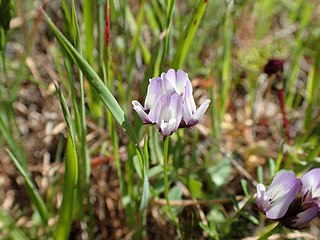
Astragalus breweri is a species of milkvetch known by the common name Brewer's milkvetch. It is endemic to northern California, where it is found in several counties surrounding the north edge of the San Francisco Bay Area. It grows in open habitat in the North Coast Ranges, sometimes on serpentine soils.
Astragalus crotalariae is a species of milkvetch known by the common name Salton milkvetch. It is native to the Colorado Desert in California and other Sonoran Deserts in Arizona and northern Mexico. It grows in desert scrub habitat, including the Salton Sink in the Coachella Valley.
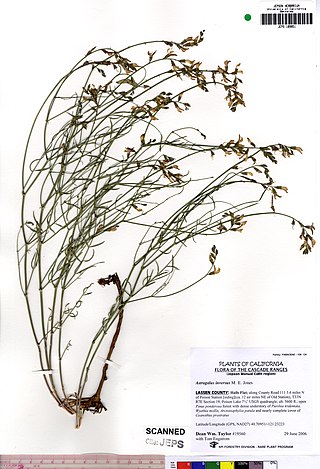
Astragalus inversus is a species of milkvetch known by the common name Susanville milkvetch.

Astragalus jaegerianus is a rare species of milkvetch known by the common name Lane Mountain milkvetch. The plant was named for the biologist Edmund Jaeger, who first documented it in 1939.
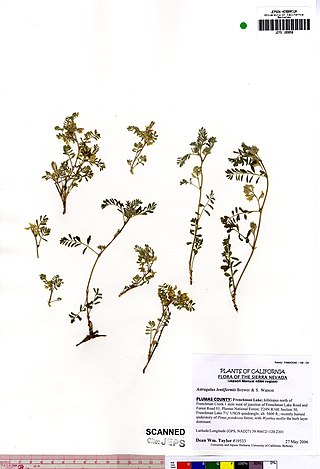
Astragalus lentiformis is a species of milkvetch known by the common name lens-pod milkvetch. It is endemic to the Sierra Nevada in eastern Plumas County, California, where it grows in chaparral scrub and coniferous forests.
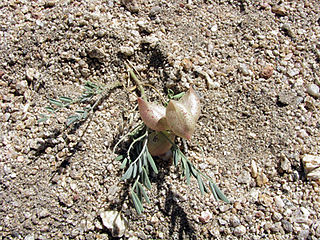
Astragalus nutans is a species of milkvetch known by the common name Providence Mountains milkvetch.

Astragalus pycnostachyus is a species of milkvetch known by the common name marsh milkvetch. It is endemic to the coastline of California, where it grows in wet saline habitat such as marshes.

Astragalus desereticus is a rare species of milkvetch known by the common name Deseret milkvetch. It is endemic to Utah County, Utah, where it is known from only one population. It was thought to be extinct until 1981 when this population was discovered. The population contains 5,000 to 10,000 plants on an area of land covering less than 300 acres. It is vulnerable to damage from grazing cattle, which eat the plant and trample the soil, and from development and erosion. This is a federally listed threatened species.
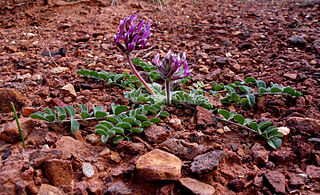
Astragalus holmgreniorum is a rare species of milkvetch known by the common names Holmgren milk-vetch and paradox milk-vetch. It is native to a tiny section of desert shrub woodland on the border between Utah and Arizona, in the far northern Mojave Desert. There are six populations remaining. It is a federally listed endangered species.
Astragalus hypoxylus is a rare species of flowering plant in the legume family known by the common name Huachuca milkvetch, or Huachuca Mountain milkvetch. It is endemic to Arizona in the United States, where it is known only from the Patagonia and Huachuca Mountains. There are three populations.

Astragalus australis is a species of flowering plant in the legume family known by the common name Indian milkvetch. It is native to much of the Northern Hemisphere, including northern North America, Europe, and temperate Asia.
Astragalus tyghensis is a species of flowering plant in the legume family known by the common name Tygh Valley milkvetch. It is endemic to Oregon in the United States, where it is known only from the Tygh Valley of Wasco County.

Astragalus molybdenus is a species of flowering plant in the legume family known by the common names Leadville milkvetch and molybdenum milkvetch. It is endemic to Colorado in the United States. If the separate species Astragalus shultziorum and Astragalus lackschewitzii are included in A. molybdenum the range expands into Wyoming and Montana.

Astragalus crassicarpus, known as ground plum or buffalo plum, is a perennial species of flowering plant in the legume family, Fabaceae, native to North America. It was described in 1813. The fruit is edible and was used by Native Americans as food and horse medicine. It is a host of afranius duskywing larvae. It is also known as groundplum milkvetch and pomme de prairie.


















